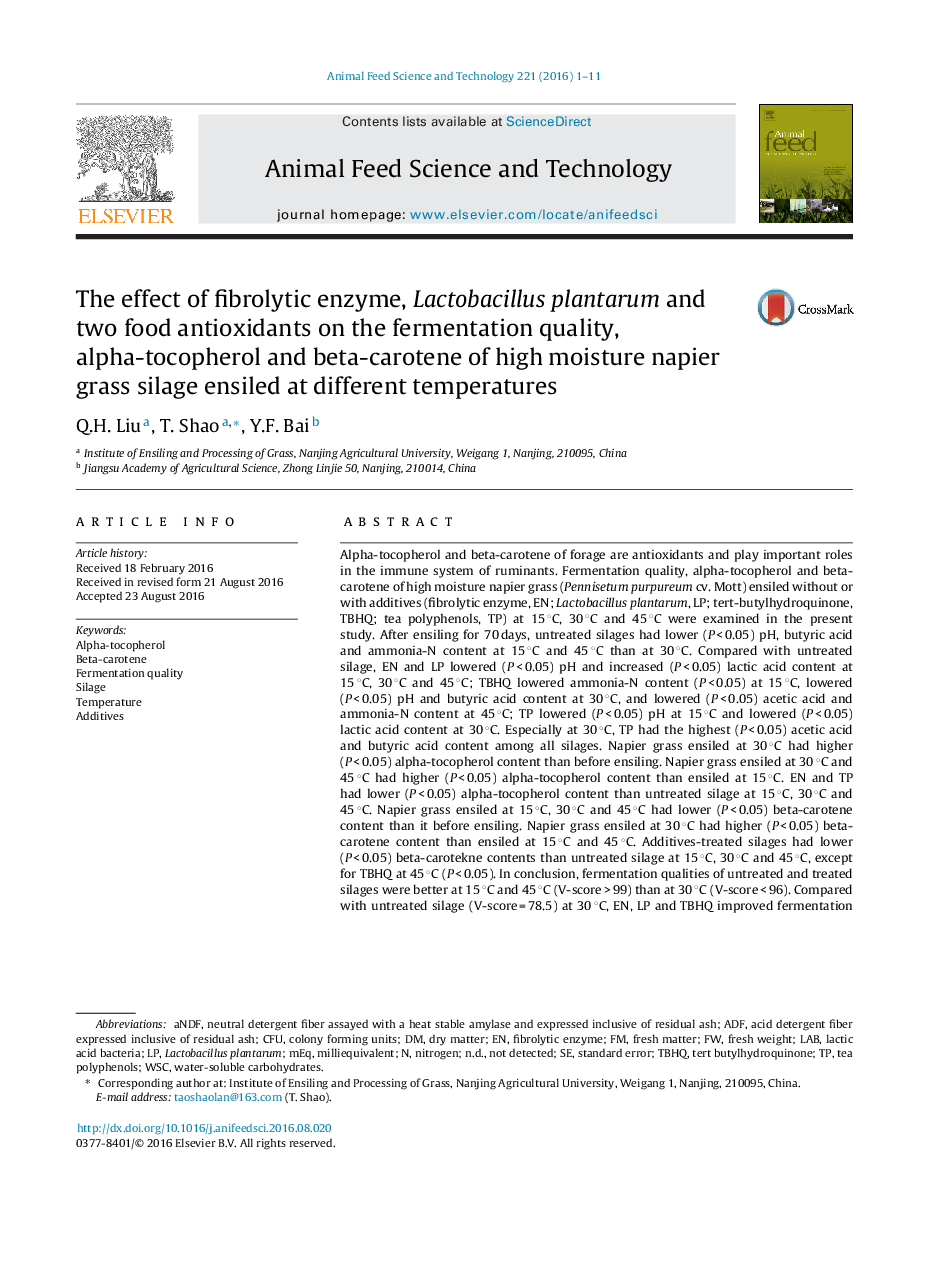| Article ID | Journal | Published Year | Pages | File Type |
|---|---|---|---|---|
| 2419215 | Animal Feed Science and Technology | 2016 | 11 Pages |
•Silage ensiled at 30 °C increased α-tocopherol and lost β-carotene slightly.•Tert-butylhydroquinone suppressed butyric fermentation of silage at 15 °C and 30 °C.•Tert-butylhydroquinone reduced β-carotene loss of silage at 45 °C.•Tea polyphenols decreased fermentation quality of silage at 30 °C.
Alpha-tocopherol and beta-carotene of forage are antioxidants and play important roles in the immune system of ruminants. Fermentation quality, alpha-tocopherol and beta-carotene of high moisture napier grass (Pennisetum purpureum cv. Mott) ensiled without or with additives (fibrolytic enzyme, EN; Lactobacillus plantarum, LP; tert-butylhydroquinone, TBHQ; tea polyphenols, TP) at 15 °C, 30 °C and 45 °C were examined in the present study. After ensiling for 70 days, untreated silages had lower (P < 0.05) pH, butyric acid and ammonia-N content at 15 °C and 45 °C than at 30 °C. Compared with untreated silage, EN and LP lowered (P < 0.05) pH and increased (P < 0.05) lactic acid content at 15 °C, 30 °C and 45 °C; TBHQ lowered ammonia-N content (P < 0.05) at 15 °C, lowered (P < 0.05) pH and butyric acid content at 30 °C, and lowered (P < 0.05) acetic acid and ammonia-N content at 45 °C; TP lowered (P < 0.05) pH at 15 °C and lowered (P < 0.05) lactic acid content at 30 °C. Especially at 30 °C, TP had the highest (P < 0.05) acetic acid and butyric acid content among all silages. Napier grass ensiled at 30 °C had higher (P < 0.05) alpha-tocopherol content than before ensiling. Napier grass ensiled at 30 °C and 45 °C had higher (P < 0.05) alpha-tocopherol content than ensiled at 15 °C. EN and TP had lower (P < 0.05) alpha-tocopherol content than untreated silage at 15 °C, 30 °C and 45 °C. Napier grass ensiled at 15 °C, 30 °C and 45 °C had lower (P < 0.05) beta-carotene content than it before ensiling. Napier grass ensiled at 30 °C had higher (P < 0.05) beta-carotene content than ensiled at 15 °C and 45 °C. Additives-treated silages had lower (P < 0.05) beta-carotekne contents than untreated silage at 15 °C, 30 °C and 45 °C, except for TBHQ at 45 °C (P < 0.05). In conclusion, fermentation qualities of untreated and treated silages were better at 15 °C and 45 °C (V-score > 99) than at 30 °C (V-score < 96). Compared with untreated silage (V-score = 78.5) at 30 °C, EN, LP and TBHQ improved fermentation quality (V-score > 83), and TP lowered fermentation quality (V-score = 74.5). Silage ensiled at 30 °C increased alpha-tocopherol content and lost beta-carotene slightly. Additives did not reduce alpha-tocopherol and beta-carotene loss at any temperature, except for TBHQ ensiled at 45 °C. The interactions between additives and preservation temperatures indicated that TP ensiled at 30 °C had the poorest fermentation quality, LP and TBHQ ensiled at 30 °C had lower alpha-tocopherol loss, and TBHQ and TP ensiled at 30 °C had lower beta-carotene loss. TBHQ might be a valuable additive to ensile napier grass at 15 °C, 30 °C and 45 °C, and to reduce beta-carotene loss of napier grass silage at 45 °C.
